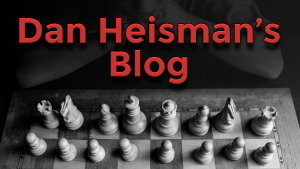Students Demonstrate Subtle Analytical Mistake
Last week, one of my students showed me a position and asked what I would do. I thought it was fairly instructive (it turned out to be!), so I will ask you the same question. In the following position, assume you are playing a long time control game (say 40 moves in 2 hours) and have plenty of time on the clock. What would you do and why? To get the most out of this instruction, don't read further until you have completed this task.
One key to beginning analysis is to notice that White has a discovered attack on c5 if he can move his knight from d4 with tempo. This should lead to the following three captures as possible candidates: 1.Nxe6, 1.Nxc6, and 1.Rxc5 (to try to lure the queen onto the diagonal of the e3 bishop). In giving this problem to a few students of various levels the weaker students might miss 1.Rxc5 but all the stronger ones considered it right away, often to the detriment of not even considering 1.Nxe6 or 1.Nxc6, but that’s getting ahead of ourselves.
In de Groot’s book Thought and Choice in Chess he calls the next stage of the thought process progressive deepening. What you should do to start is take 20-45 seconds and look briefly at each of the three strong candidates to try to get a feel for which one you think is most likely best. To take longer on any one candidate at this point (which several students did) is to just waste time; if there's another clearly better move, you don't want to spend ten minutes on a lesser one (Purdy: "Look wide before you look deep"). You are trying to find the best move you can in a reasonable time, not necessarily determine exactly how good is the move you wish to play.
Once you have determined which move is the most promising, it is time to examine it in more detail, putting the other moves away as possible improvement for later. Most students chose the move 1.Rxc5. It so happened that I chose 1.Nxc6 as the first move to examine more deeply, but the first choice does not always matter as much so long as your logic is good and you eventually get to the finish line correctly; I had to get to 1.Rxc5 and 1.Nxe6 soon enough. The key point is that you should now get a better feel how good your first candidate is, so you can then compare it to the others.
In the case of 1.Rxc5, all the stronger students pretty quickly realized that 1…Qxc5 was hopeless due to the discovery 2.Nxe6 when the queen is attacked by two pieces and the rook on f8 is also forked. Therefore, when the smoke clears, White is bound to be ahead by at least a piece.
That means 1…Nxd4 is Black’s only other try to save material (he can just ignore 1.Rxc5 but then he is down a piece, so not many players as Black would do that!). One stronger student did the problem too quickly and did not even get this far, assuming that if 1…Qxc5 lost then 1.Rxc5 won, and did not go further. That could have been a monstrous mistake if 1…Nxd4 turned out to be a good defense.
This is where my initial student had a problem. He looked at 1...Nxd4 and saw that 2.Rxc8, 2.Bxd4, 2.Nxd4, and 2.Qxd4 were all candidates and started to despair! He said he felt like he was not that fast at calculating and that it might take him all day. He was surprised when I responded that was not necessarily so - you don't usually have to figure out exactly how good all the lines are, as we shall see!
After 1.Rxc5 Nxd4 most students assumed White should play 2.Rxc8, but I did not approach it that way. I considered that White’s four tries were 2.Rxc8+, 2.Nxd4, 2.Bxd4, and 2.Qxd4. But then I noticed that 2.Qxd4 simply held the rook on c5 twice and there were no more complications – White is ahead a piece.
This is where the most instructive part occurs => At this point, after finding 2.Qxd4, I pretty much don’t need to look at 2.Rxc8 also – it’s not relevant unless either 1.Nxc6 or 1.Nxe6 also wins a piece, when I might wish to know if 1.Rxc5 wins more than a piece (which it can’t, since Black can always just stop after 1.Rxc5 and make some innocuous move remaining down the bishop).
Several students protested, “How can this be? Don’t you wish to find the strongest move?” My answer was logical. Yes, I want to find the strongest move on the move I am considering (the first move), but I don’t always need to find the strongest move on my second move of the sequence to prove that I have found the strongest first move! So if 1.Rxc5 Nxd4 2.Qxd4 leaves me ahead a piece then, unless 1.Nxc6 or 1.Nxe6 also wins a piece, this proves that 1.Rxc5 is best, and I don’t need to know how much better my choice can be if Black tries 1…Nxd4 and I play 2.Rxc8. That’s just a waste of time at this point.
In other words, if I am analyzing three candidate moves A, A’, and A”, and I see the move sequence A,B,C, where if B is the dangerous key reply for my opponent, I only need to find a C such that it proves A is the best move. I don’t need to find the best C at this point if the C I find is sufficient to yield a better position than the other lines A’,B’,C’ and A”,B”,C”, assuming their C is best. In this case that means if 1.Nxe6 and 1.Nxc6 don’t win a piece and if 1.Rxc5 Nxd4 2.Qxd4 does, then I don’t need to find a move better than 2.Qxd4 to prove that 1.Rxc5 is best, even if there is a move better than 2.Qxd4. Looking for one is irrelevant and a waste of time! This is what my initial student (and several others) did not understand. They thought they had to figure out how everything in order to determine the best move. (Note: this logic also works the other way around: If you analyze 1.Rxc5 Nxd4 2.Rxc8 and find it wins a piece or more first, then you don't necessarily have to analyze 2.Qxd4 too at this point).
Well, we do have to consider the other two candidates for White's first move, so let’s next analyze 1.Nxe6. This capture would work great if Black was forced to recapture 1…fxe6?, allowing 2.Bxc5 or even 2.Rxc5. Howver, pretty much everyone found that Black could instead reply 1…Bxe3 hitting White’s queen, which is sufficient to maintain the balance.
However, the same idea does not work for Black after 1.Nxc6, when 1…Bxe3? is bad because of the zwischenzug 2.Ne7+, which some students missed. Therefore, Black needs to recapture on c6 in a way that guards c5, so 1…Rxc6 is forced. But then White’s only attempt to win material would be the pseudo-sacrifice 2.Rxc5 Rxc5 to try to take advantage of the pin on c5. But even if White somehow wins the pinned rook he would only net a piece, which is as much as he can win with 1.Rxc5 anyway. And the prospect that 1.Nxc6 Rxc6 2.Rxc5 works looks superficially doubtful.
A sure win of a piece is better than a possible win of a piece, so I would reject 1.Nxc6 as well. Therefore, I have found that 1.Rxc5 is thus the best move. However, in a slow game if you see a win of a piece (or any move that seemingly wins), that is a red flag that the move is super-critical, so I would check my analysis several times before playing such a seemingly winning line. Playing it quickly is not a sign of intelligence that you figured it out so quickly, but rather a sign that you are not so wise as to be careful.
Finally, let’s assume White does play 1.Rxc5 and the opponent replies 1…Nxd4. What would you do now?
I’ll tell you what I would do. First I would re-analyze my “C”, in this case 2.Qxd4, to make sure it really is as good as I thought it was. If it continues to check out as just as effective as I thought, then I would likely put it in my pocket as the best move (“King of the Hill”) and look for a better one. The leading alternative is 2.Rxc8, and, unlike on the previous move, now I would be very interested to see if I could do even better than 2.Qxd4. It’s tempting to just play 2.Qxd4 since this wins easily, and I would do so in any short time limit game or if short on time. However, with so much time on my clock, I would look to see if I could win even more than a piece, say a rook or even two pieces with 2.Rxc8, making the win all that more secure. Of course, if 2.Qxd4 (or any "C") put me ahead a queen or led to a trivial checkmate, I would not bother to look for a better move.
In practice, many of my students, after analyzing ABC, when they actually do move A and the opponent replies B, they play C right away, even if it does a lot less than win a piece (it did win a piece in the above position). Immediately playing your previously calculated move is a terrible mistake in long time control games for the two reasons: 1) You can visualize C better once A and B have been played, so you should always check your analysis even if you did it thoroughly last move - you might find an error now that you can "see" better, and 2) Just because your analysis was correct does not always mean that C is best (as we showed earlier). Therefore, even if your analysis was correct then, unless you are winning trivially or short of time, it makes sense to follow Lasker’s Rule: If you see a good move, look for a better one.
Consistently practicing this analytical philosophy in cases like this could make the difference between being 1800 and 1900, which is probably a lot more than you would get if you took a pill memorizing an opening book!






